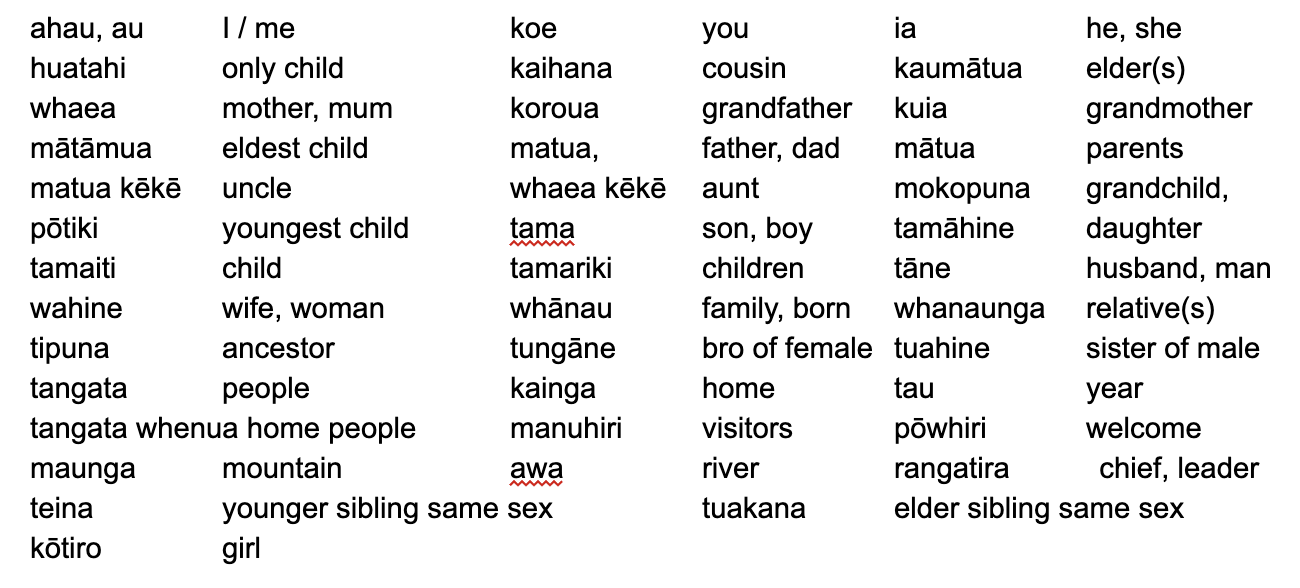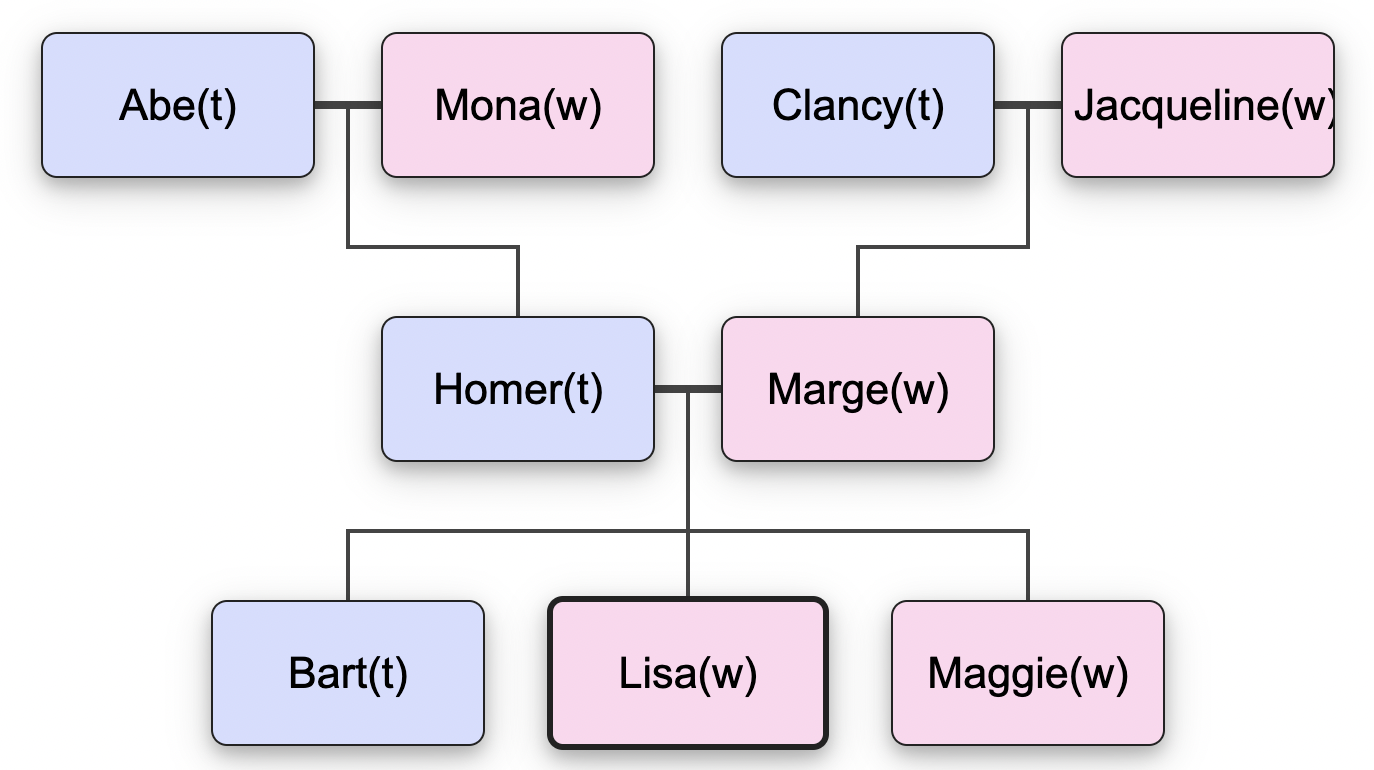9 Te Reo Māori 1
Section outline
-
Mihimihi
E te whānau, ngā mihi o te tau hau ki a koutou katoa. Nau mai haere mai ki te reo Māori 2022. Ko te tumanako, he pai a tātou haerenga ki te reo i tēnei tau.
TOPICS
- Ko au me tōku whānau
- Tōku kainga
- Kai
- Ngā tau
Course overview
Students will be able to:
- Demonstrate an understanding of some common tikanga Māori
- Communicate about themselves and their families
-
-
Prepare a profile about yourself on a poster or a google slideshow in te reo Māori.
You should include (but are not limited to) the following information in your presentation
- Tōku Pepeha
- Tōku Whakapapa: Your family Tree
- Tōku Whānau: A description of your immediate family including grandparents
- Likes & Dislikes
- Favourite things
This is an individual assessment. You must submit your profile by Thursday 11 May 2023
-
-
EXPLORE / TŪHURA learning intentions:
- We are EXPLORING...tikanga māori so students can compare with their own cultural customs
- We are EXPLORING...pepeha so students can discover and connect with their ancestral homelands
- We are EXPLORING...whakapapa so students can draw a family tree
Whakawhanaungatanga
In this first week or so we will learn to get to know each other better and build relationships (whanaungatanga). We also begin to learn a new karakia and review how to do a simple mihi to introduce ourselves.
-
Ko wai au me tōku whānau?
This week we will begin learning a simple mihi to introduce ourselves and learn new vocabulary to describe our family members. We will also research our whakapapa in order to learn a true pepeha.
Research Task: Research the following:
Non-Māori students
Research the place where one of your ancestors come from (e.g. India, South Africa, Samoa, China, etc)
Write down the name of the person who came from this place and who they are (grandmother, grandfather etc)
- Name the country, city, town or village they came from.
- Find out some information about this place and write a description of it. It may include:
- Geographical features
- Name of nearest mountain, river or sea to this town or village.
- Famous landmarks
Māori Students
Find out your iwi and if possible name of your marae or even the pepeha for that marae.
-
Ko au me tōku whānau
Kupu Hou (Vocabulary)

Asking who?
To ask who someone is we use the question, "Ko wai?"
Ko wai ia? Who is he? Ko Stan Walker ia. He is Stan Walker
Tasks on google classroom
-
FOCUS / ARONGA learning intentions:
- We are FOCUSING...on vocabulary to describe family members in te reo Māori
- We are FOCUSING...sentence patterns to introduce ourselves and our family in te reo Māori
Whakapapa
Whakapapa is our family history or genealogy. It’s knowing who we are and where we’re from. It provides us with identity and history, and connects us with our tūpuna with our tūpuna, whānau, whenua, iwi and marae.
Whakapapa was traditionally passed down through kōrero and waiata, as well as shared through carvings and karakia.
-
Whakapapa Learning Outcomes
You should be able to:
- draw whakapapa charts accurately
- describe relationships between people on a chart
- draw own whānau whakapapa chart
- describe all members of whānau on chart
Ko (name) te [whaea] o (name)
Ko (name) te matamua/potiki
Ko (name) te tua ....
Tasks

Tasks
i) Ko wai te matua?
ii) Ko wai te whaea?
iii) Ko wai te mātaamua?
iv) Ko wai te tuarua?
v) Ko wai te pōtiki?
vi) Ko wai te māmā o marge?
vii) Ko wai te pāpā o Marge?
ix) Ko wai ngā mātua?
x) Ko wai ngā kuia?
xi) Ko wai ngā koroua?
-
Tōku whānau mē tōku whakapapa
Draw your own whakapapa chart including your grandparents.
Write sentences to describe each person in your family
Put all of this on a slideshow
-
PLAN & DO / WHAKAMAHI learning intentions:
- We are PLANNING... so that we can...
- introduce ourselves in te reo māori
- say an appropriate pepeha that connects is to our ancestral homelands
- Present our whakapapa and describe each of our family members in te reo Māori
Tōku Pepeha
Over the next few week you will learn about pepeha. In te ao Māori, your pepeha connects you to your whakapapa and goes all the way back to the creation of the world when the sky father Ranginui and mother earth Papatuānuku were separated to allow light to come into the world. We recognise our mountain, river or ocean,waka, iwi, hapū, and our marae (including wharenui & wharekai). The last thing we acknowledge is ourselves because we as humans were created last.
For non-māori, your pepeha should also take you back to where your ancestors came from and acknowledge the mountain, rivers etc that relate to that place.
You will need to do some research about where your ancestors originally came from so that you can connect to them and their home land.
-
Learning Outcomes
You should be able to:
- ask how many objects or people
- say how many objects or people
Asking How many objects?
When we want to ask how many objects there are we use the phrase “E hia ngā ……..?”
E hia ngā āporo? How many apples? E rua ngā āporo. There are two apples
Note: The question word “hia” is replaced with the answer (two or rua)
If there is only ONE we would reply “Kotahi te….”
Kotahi te āporo
Asking How many people?
When we want to ask how many people there are we use the phrase
“Tokohia ngā …...?” instead of E hia ngā …….?
Tokohia ngā tamariki? How many children?
Tokowhā ngā tamariki. There are four children
However, we only use “toko” for 2-9 people. For 10 or more people we go back to use ‘E (number)’ like withj objects.
If there is only ONE person we would also reply “Kotahi te……...”
E.g. Kotahi te tamaiti There is one child.
-
Nau mai hoki mai whānau. This week we are starting our assessment
-
For the next two weeks you will be working on your assessment in class.
-
This week your are to complete your assessment to submit on MHOL
-
EXPLORE / TŪHURA learning intentions:
- We are EXPLORING...Māori land wars by investigating and analyzing how the past is important to people
- We are EXPLORING...Māori land wars by researching and conceptualize how those events have causes and effects
Paearu Angitu / Success Criteria: I can/have...
- Understand how the past is important to people
- Understand that events have causes and effects
- Reflection on research in library from last lesson
- Creation of a town: Te Tiriti o Waitangi (Art)
- Tiriti o Waitangi (Fill in words activity)
Mahi Kāinga / Homework:
- Yr9 Māori land war assessment
-
EXPLORE / TŪHURA learning intentions:
- We are EXPLORING...Māori land wars by investigating and analyzing how the past is important to people
- We are EXPLORING...Māori land wars by researching and conceptualize how those events have causes and effects
Paearu Angitu / Success Criteria: I can/have...
- Understand how the past is important to people
- Understand that events have causes and effects
Hei Mahi / Activities:
- Check and mark Tiriti o Waitangi (Fill in words activity on Google Classroom)
- Read through and discuss Te Tiriti o Waitangi by Ross Calman (Article)
- Briefly look into New Zealand Wars (Instagram Account)
Mahi Kāinga / Homework:
- Yr9 Māori land war assessment
-
PLAN & DO / WHAKAMAHI learning intentions:
- We are PLANNING to apply our understanding of Māori land wars so that we can present a oral report in class
Paearu Angitu / Success Criteria: I can/have...
- Understand how the past is important to people
- Understand that events have causes and effects
- Make connections with known culture(s).
-
PLAN & DO / WHAKAMAHI learning intentions:
- We are PLANNING
-
EXPLORE / TŪHURA learning intentions:
- We are EXPLORING Communicate about time, weather and seasons
Paearu Angitu / Success Criteria: I can/have...- .
- .
Hei Mahi / Activities:
- Manawataki
- Outdoor A4 Poster
- We are EXPLORING Communicate about time, weather and seasons
